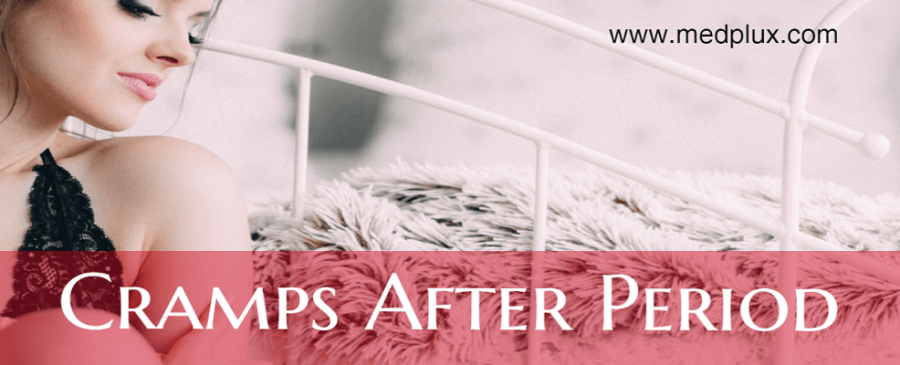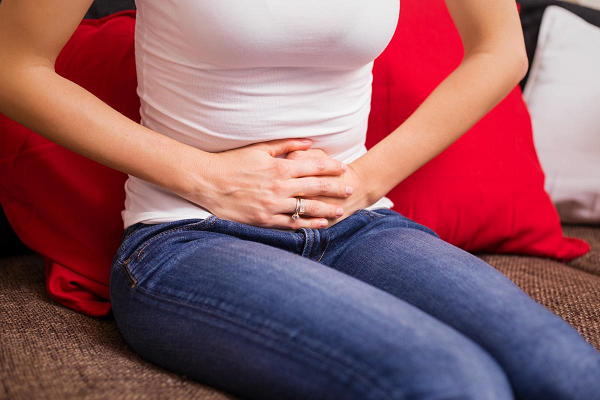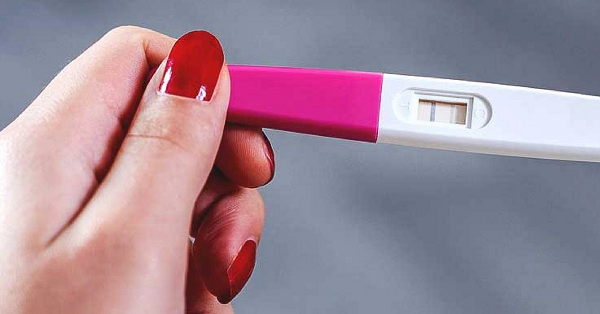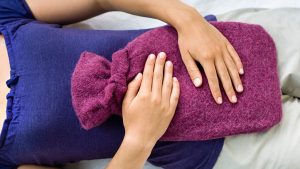Cramps After Period Has Ended: 7 MAIN Causes, Treatment

Last updated on July 26th, 2018 at 06:03 pm
Question: Is lower back pain and cramps after period normal or a sign of pregnancy?
During menstruation that occurs monthly for most women, pain in your lower abdomen may sometimes force you to change your routine daily work or planned activities.
This pain is common in women, and its nothing unusual. In fact, more than 80 percent of women will have experienced a mild to moderate sharp pain before and during menstruation.
This pain occurs because your womb contracts and relaxes, and expels the endometrial lining that covers the inside of the uterus. As your uterus contracts, it temporarily blocks blood supply to your uterine muscle, resulting in dull or sharp abdominal pain.
While some women will notice severe abdominal cramps during their period, others may only get a mild to moderate cramps in their belly
After period stops at the 5th to 7th day of bleeding, women get this relief from the emotional and physical PMS symptoms that you may experience. Therefore, if you now have cramps after your period, its normal you will be concerned.
The truth is, not all cramps mean a serious health concern. Some women will naturally experience pelvic pain after period when uterus cleans itself by expelling “Left-over endometrial tissues”.
If this happens, surely you will experience spotting and cramping after your period; And in a few days time, symptoms will subside on its own.
Though cramping after period may not mean a serious health concern, in some women, it could be a sign of a medical issue.
Pelvic inflammatory disease, complicated vaginal infections, uterine fibroid, endometriosis, adenomyosis, ovarian cyst rupture may cause severe belly cramps after the end of menstruation.
This article explains the causes of spotting and cramping after menstruation ends, signs that indicate it could be pregnancy, and danger signs that signify something more serious.
What causes cramps after period has ended?
If your period ended but still cramping, here are possible causes
1. Uterine incapacity
Your uterus is made of muscle that works to contract and relax while you are having menstruation. This contraction helps to push out period-blood from your womb out through your vagina.
As contraction occurs, you will feel pain in your lower abdomen, pelvic region, and back.
If all endometrial blood is not expelled out of your womb, your body forces your uterus to contract after the end of period resulting in cramps in your abdomen
During this time, you may experience a black, dark or brown spotting that occurs for a few days.
2. Pregnancy
Cramping after menstrual period may be due to implantation bleeding. Implantation bleeding is spotting by some pregnant women after the embryo is successfully attached to the uterus. During this process, it may you to feel stomach pain and also have brown vaginal spotting.
The truth is, implantation cramps and spotting occurs around the 3rd week of pregnancy, that is, a week before your next menstrual period.
In women that experience implantation cramps, it’s mild, and will not be intense like your period pain.
Implantation bleeding is short-lived, and you will also experience other pregnancy symptoms like mood changes, feeling tired and unwell, urinating much more than normal, breast heaviness, breast pain with itching around your nipples.
If you’ve already had sexual intercourse, take a pregnancy test to determine if you are pregnant or not. This is especially vital if you are worried why you had a scanty period.
A blood test is more accurate, though, First Response pregnancy test strips has an accuracy of 95 – 100 percent after your period.
3. Ovulation cramps
If you have cramps 2 weeks after period has ended, it’s likely to be ovulation cramps. In women with a short menstrual cycle, cramps 1 week after period is also a sign you are ovulating.
Ovulation means the release of an egg from your ovaries, and it’s normal that women between 13 and 50 years ovulate in each menstrual cycle. This is because, without regular ovulation, it’s difficult to conceive.
During ovulation, women experience spotting and cramping in their lower abdomen. These cramps are short-lived, and within hours or few days, the pain will subside completely.
Apart from ovulation cramps, a clear watery and stretchy vaginal discharge is a way you can identify ovulation period. Other symptoms are back pain, abdominal bloating, increase sexual desire, Excessive vaginal discharge due to elevated estrogen, and mid-cycle spotting.
4. Pelvic inflammatory disease
Vaginal and uterine infections commonly happen in women with poor hygiene and those that engage in unprotected sexual intercourse with multiple partners.
If you have pain in your vagina with an abnormally foul-smelling discharge, it’s a sign you have a vaginal infection.
Like most women that catch sexually transmitted diseases (gonorrhea, chlamydia, trichomoniasis), symptoms will not be apparent, and you may suddenly feel pain in your abdomen.
Persistent pain in your lower abdomen means something is wrong, and it could be due to pelvic infections.
Other symptoms of pelvic inflammatory disease are
- Fever that may be persistent throughout the day
- Painful sexual experience
- Painful urination
- Upper abdominal pain
- Smelly vaginal discharge (with green or yellow color)
- Body weakness and fever
If you have cramps all the time after your period is finished, it could be due to infections if you have these symptoms too.
For best treatment, it’s vital you inform your doctor for routine urine culture and other blood tests. Usually, after culture, your doctor will start you on antibiotics and pain relief medications.
5. Endometriosis
With more than 50 percent of women having endometriosis, your pelvic pain during and after the end of menstrual period may be due to endometriosis.
Within your womb is the endometrium that builds-up before the start of a period. When your period begins, your uterus contracts and expels your endometrium as bright red period blood.
These endometrial tissues are usually located inside the uterus; if they become displaced and found in other parts of your body, it may cause severe pain during and after period.
Other symptoms of endometriosis (apart from pain) are longer than usual menstrual period now lasting more than seven days, severe cramps in you back, Pain while having sexual intercourse, infertility, spotting between periods, heavy menstrual bleeding during periods.
If you persistently get severe lower or upper abdomen pain, either on the right or left side of your abdomen, talk to your doctor.
Endometriosis can be managed with pain relief medications, though a complete cure is not currently possible.
6. Adenomyosis
Just like endometriosis, adenomyosis involves the displacement of uterine endometrial tissue, but this time, endometrial tissues are located within the muscle of the uterus.
This is common in women that have previously had a vaginal delivery, or operational delivery through cesarean section. Also, if you’ve had an abortion through a D & C procedure, it could result in abdominal pain.
Other causes of pelvic pain after a period are hormone imbalance, stress, emotional instability, birth control pills, and ovarian cyst rupture.
How to ease cramps after period
If you have cramps that are mild and due to implantation, within hours to a few days, you will start feeling better.
However, some women will experience a severe pain after the end of period that will require urgent treatment.
These are easy ways to feel better
1. Use painkillers
Most pain medications block the synthesis and release of prostaglandins, a hormone that stimulates the uterus to contract and cause pain.
Drugs like naproxen, ibuprofen, aspirin, and acetaminophen can help. If you’ve confirmed pregnancy, it’s important you see your doctor before taking any medications. This is because, during the first trimester, some drugs are contraindicated.
2. A warm bath and heating pads
Take a warm bath to ease off the pain. If you have a heating pad, you can also apply to relieve your cramps.
3. Get physical, have sex and exercise
Women that routinely exercise will notice a reduction in menstrual cramps.
4. Talk to your doctor
Some cramps in your belly may require further testing and treatment you cannot apply at home. See your doctor for help.
Cramps 2 days after period
If you start getting cramps 2 days after period, it also likely your endometrium that was left over is being expelled. Cramps 3 days after period or cramps 4 days after period may be due to the same reason.
Nevertheless, a smelly vaginal and persistent pain may signify something more serious.
